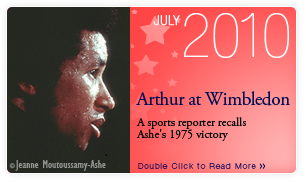Arthur at Wimbledon | A sports reporter recalls Ashe’s 1975 victory
I was visiting with two of my cousins in upstate New York when Arthur faced Jimmy Connors in the final. We all watched with great delight on television. Connors had never lost to Ashe in three previous career meetings. The contentious left-hander was the defending champion and the overwhelming favorite to retain his crown, but Arthur thoroughly caught Connors off guard. He played arguably the most cerebral match of his career. In years gone by, Ashe had been celebrated for his spectacularly flamboyant shot making. He could sometimes be almost recklessly ambitious with his tactics, and was always adventuresome. But on this occasion he was as disciplined and determined as he had ever been. He produced a masterpiece of strategic acumen, toppling Connors 6-1, 6-1, 5-7, 6-4 with a wide and dazzling array of speeds and spins, and a surgical serving display. His victory was celebrated gleefully by fans from every corner of the globe who realized what a mighty achievement it was for him to bring down the mighty and seemingly invincible Connors.
A few days later, Arthur gave a press conference in New York with ATP Executive Director Jack Kramer, and when he was introduced, a few of my colleagues and I rose to shower him with a standing ovation, a gesture seldom made to a player under those circumstances. Others joined us in applauding a tennis champion who was so much larger than the game he played, and so much bigger than the sum of his accomplishments. In the weeks and years to come, I often spoke with Arthur about his performance against Connors. He told me that after he had won the first two sets so easily, he looked up at the clock in the Centre Court. He said to himself, “Hey, I’m not supposed to be beating Connors so easily. But I couldn’t believe it, because the clock told me it was only 2:41, [the match started at 2PM]. I had thought it had to be at least 3:15 or 3:20. I really think if I had not looked up at that clock, I would have beaten Connors in straight sets. That snapped me out of a time warp.”
Arthur was surprisingly modest about his inspirational performance against Connors. He informed me he was amazed how many errors Connors made, and yet he knew that he had been largely responsible for the frailty of Connors because he had confounded his younger opponent so much with his unexpected strategy. I once asked him to put the public response to his victory in perspective, and he replied, “I might be standing in an elevator somewhere, or walking down the street, and somebody always seems to come up to me to say something about that Wimbledon win. Among whites, they say it was among their most memorable moments in sports. Among blacks, I’ve had quite a few say it was up there with Joe Louis in his prime and Jackie Robinson breaking in with the Dodgers in 1947. Once a month somewhere, somebody brings up that Connors match to me.”
–Steve Flink, Senior Columnist www.TennisChannel.com

